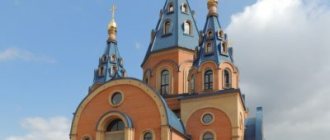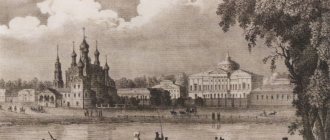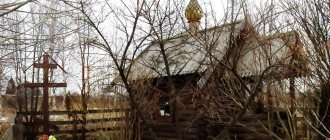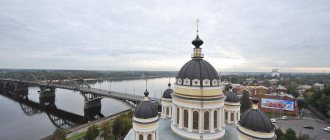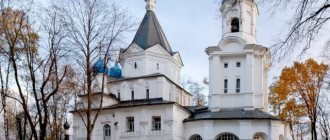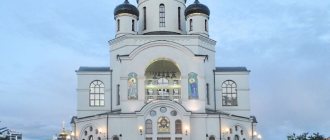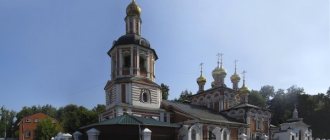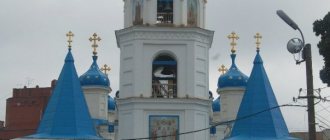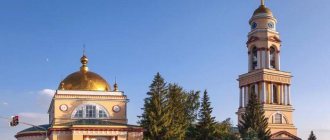Church of the Ascension at the Sklifosovsky Research Institute: history
In general, if we talk about the Church of the Ascension at the Sklifosovsky Hospital, then two points should be noted:
1. On the territory of the hospital there is another “main” church - Trinity, and it is this one that is associated with the “temple at Sklifa” in the first place. It is larger and was built earlier. Although, unlike the Church of the Ascension, it is formally a brownie, since it is located in one of the buildings - the one with a colonnade:
2. Once upon a time, the Church of the Ascension was not a temple, but was simply a hospital chapel - that is, it did not have an altar and the Liturgy could not be served in it.
By the way, the church at the Pirogov hospital had a similar fate. The only difference is that the chapel there was initially so small that in order to build an altar, it had to be completed. And the Ascension Chapel from the very beginning was the same size as it is now:
It was built in 1882. Immediately after the revolution it was closed. It was rebuilt into a regular building. A second floor was added. The building first housed a school, and then, from 1979 to the 1990s, a personnel department:
In the early 2008s, the Church of the Ascension at the Sklifosovsky Research Institute was consecrated and Liturgies began to be served there. Before this, it was restored to its original appearance.
Opposite the temple there is a site for a medical helicopter:
Entrance to the temple from the other side:
On the side: a large hospital park where patients sometimes walk:
Quiet hospital area:
Behind the trees you can see the gigantic main building, which was built during the Soviet era:
Father Vasily died on February 4, the day of the Apostle Timothy. He was the rector of the Church of the Life-Giving Trinity at the Institute. Sklifosovsky. Father Vasily served where death is four steps or less - in the church at the Research Institute named after. Sklifosovsky. He consoled the deified, the broken, the crippled. Everyone who knew Fr. Vasily, they knew that he was an incredibly kind person, and a priest who always came to the rescue. He came to give communion to the sick across the whole city, and he consoled the one who was dying with love.
Farewell to Fr. Vasily will be held on Sunday, February 7, throughout the day in the Church of the Resurrection of Christ (small church) at the Research Institute. Sklifosovsky. On February 8, Monday, a funeral liturgy and funeral service will be served in the Church of the Life-Giving Trinity (large). Liturgy begins at 8 o'clock.
Address: Sukharevskaya square, 3, bldg. 1 The entrance to both churches is located on the territory of the Sklifosovsky Research Institute and is open to all believers.
https://www.miloserdie.ru/article/umer-osvyashhennik-vasilij-sekachev-vsegda-speshivshij-na-pomoshh/
Everyone who knew Fr. Vasily, they knew that he was an incredibly kind person, and a priest who always came to the rescue. He came to give communion to the sick across the whole city, and he consoled the one who was dying with love. Quiet, delicate, he never got into the soul and did not preach where he was not wanted. How many people did he help!
Father Vasily was seriously ill (pancreatic cancer), and knew about his diagnosis from the very beginning. The best specialists fought for his life. When the website Miloserdie.ru announced a fundraiser for the treatment of Fr. Vasily in Germany, this request for help was closed in record time.
Father Vasily Sekachev graduated from Moscow State University, served in the army, studied modern history, defended his PhD thesis, and worked at the Institute of Europe of the Russian Academy of Sciences. In 1998 he was ordained a priest. First he served in the Church of St. Tsarevich Demetrius, then in the Church of the Life-Giving Trinity at the Research Institute named after. N. Sklifosovsky. Father served there for many years. Institute named after N.V. Sklifosovsky is an unusual hospital; the very specifics of the work here make you think about the “eternal.” Father Vasily taught history at the St. Dimitrievsky School of Sisters of Mercy and at the Dimitrievsky School, taught students at the St. Tikhon Orthodox Humanitarian University the history of the Russian Church.
For us o. Vasily wrote articles in Neskuchny Sad and for the website Miloserdie.ru. He was a very responsible correspondent and if, due to his workload, he missed a deadline, he always asked him to excuse him ten times. I thought about the text thoroughly, and if I thought I didn’t know the question, I honestly refused. And I was ready for reconciliations even at one in the morning. When in Neskuchny Sad we wrote about what modern people are afraid of and don’t want to know, we asked Fr. Vasily - as a priest who has seen people in the most extreme situations, when there is no longer any strength for masks and pathos, when death is four steps or less. This is what he answered us: “The main fear, it seems to me, is the fear of humility. Yes, a person’s greatest fear is that he will not be noticed, will not be appreciated, will not be given something, and will be among the deprived, the humble. Our common problem is that we cannot trust God. We cannot believe that there is One who loves us most. In general, we don’t really believe in love, but more in ourselves, in some people, some circumstances, the possibilities of this world, but not in God’s love for us. That’s why it’s very difficult for us.”
Farewell to Fr. Vasily will be held on Sunday, February 7, throughout the day in the Church of the Resurrection of Christ (small church) at the Research Institute. Sklifosovsky.
Church of the Resurrection of Christ On Monday, February 8, a funeral liturgy and funeral service will be served in the Church of the Life-Giving Trinity (large). Liturgy begins at 8 o'clock.
On February 8, Monday, a funeral liturgy and funeral service will be served in the Church of the Life-Giving Trinity (large). Liturgy begins at 8 o'clock. Address: Sukharevskaya square, 3, bldg. 1 The entrance to both churches is located on the territory of the Sklifosovsky Research Institute and is open to all believers.
What is the Sklifosovsky Institute hiding?
It all started in the first half of the 17th century, when Tsar Mikhail Fedorovich Romanov granted the princes of Cherkassy a large plot of land, which later became known as “Cherkassy vegetable gardens”. It approximately coincided with the modern territory of the Institute of Emergency Medicine.
In the 1640s, there was a summer residence of Prince Yakov Kudenetovich Cherkassky. As can be seen from the patronymic, this generation of Cherkasskys had not yet fully assimilated and retained the imprint of their Caucasian origin.
Yakov Cherkassky built a wooden tented church in honor of Saint Xenia at his court. After the pestilence of 1654, Cherkasy vegetable gardens became deserted. After 30 years, Prince Mikhail Yakovlevich Cherkassky restored the temple, which soon found itself in the shadow of the Sukharev Tower.
The next owner of the plot is Prince Alexey Mikhailovich Cherkassky. He was an opportunist, so he found a common language with all the emperors from Peter I to Elizabeth. Prince Alexei built the Peter and Paul Fortress and Peterhof Palace and served as governor of Siberia. His daughter, Varvara Alekseevna, the richest bride in Russia, married Count Pyotr Sheremetev. So the Sheremetevs became the richest family in the country.
The Sheremetevs lived in Kuskovo, where Count Nikolai Petrovich Sheremetev was born. Subsequently, he fell in love with his serf actress Praskovya Zhemchugova. They lived happily, but not for too long: the girl was undermined by tuberculosis.
In the early 1790s, Praskovya secretly went to Sukharevka to give alms to the poor (at that time Sukharevka was not yet a black market). When the count found out, for the sake of his wife, he decided to give his Cherkassy vegetable gardens to the Hospice House to alleviate the lot of the poor. The count founded the building on his birthday - June 28, 1792 - and buried silver coins in the foundation for good luck.
At first, the Hospice House looked modest. Architect Elizvoy Nazarov, a former serf, built two simple semicircular wings with the Trinity Church in the middle. In one wing there is a hospital, in the other there is an almshouse (nursing home). Both are free, at the expense of the Sheremetevs.
Social activity
According to the spiritual will of Praskovya Sheremeteva, funds were allocated annually for dowries to “poor and orphaned girls.” Girls in need of help drew lots on February 23, the day of memory of Praskovya, and orphan brides were married in the Trinity Church of the Hospice House.
More than 200,000 people received help at home. Since the beginning of the 19th century, the Moscow branch of the Medical-Surgical Academy settled here. By the end of the century, the hospital’s ties with Moscow University were strengthened: in 1884 it became its clinical base. Leading scientists of the country V.D. Shervinsky, S.S. Zayaitsky, N.N. Savinov, S.N. Dobrokhotov and S.E. Berezovsky are introducing advanced treatment methods here.
An important stage in the history of the house was the work of the chief doctor, Alexey Terentyevich Tarasenkov. Under him, hospital care was significantly improved: outdated prescriptions for drugs were replaced, control over their purchase and prescription was established, and regular rounds and examinations of patients were established. He suggested to the then trustee of the house, Count S.D. Sheremetev to open a “coming department” - a free outpatient clinic, as well as a medical fund for issuing benefits to patients upon discharge for the first time, which was done.
During its operation, the Sheremetevskaya Hospital more than once turned into a hospital. After the Battle of Borodino, wounded soldiers and officers were brought here. On the day the French entered Moscow, the house was empty, 32 infirm and elderly people remained in the almshouse, and 11 wounded Russian officers remained in the hospital. Some employees and doctors stayed with them voluntarily. Mistaking the Hospice House for a manor house, the French began to rob it, but when they learned that it was a charitable institution, on the contrary, they posted a guard there. Many valuables were nevertheless stolen. During the fire, the Sukharevsky and Doctor's wings were damaged, only the walls remained. The house took several more years to be restored.
During the terrible cholera epidemic of 1830, no one fell ill in the Hospice House.
During the Crimean War, a sanitary detachment of doctors was assembled here. During the Russo-Japanese War, the infirmary operated on a charitable basis. Later, participants in the revolutions of 1905 and 1917 were treated. In 1919, the Moscow city emergency medical care station was organized in the Hospice House, and since 1923, one of the buildings of the Research Institute of Emergency Medicine named after. N.V. Sklifosovsky. The initiative to restore the Hospice House and return it to its former glory belonged to the surgeon Sergei Sergeevich Yudin.
Chief surgeon of the Research Institute named after. Sklifosovsky S.S. Yudin was the elder of the Trinity Church and donated the Stalin Prize for the restoration of its paintings.
In 1986, the Central Museum of Medicine opened here, which in October 1991 received the status of the Research Institute of the Russian Academy of Medical Sciences.
The ensemble of the Hospice House - the main building, two side wings, two wings in the courtyard, a gate and a fence, a fresco by Giovanni Scotti in the dome of the church, high reliefs in the interiors of sculptors G. Zamaraev and T. Timofeev - is included in the list of cultural heritage sites of federal significance and is included in provisional UNESCO World Heritage List.
